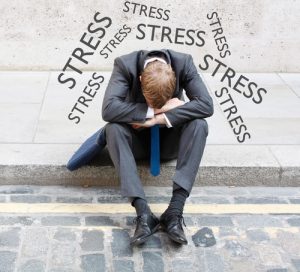Worker burnout is a big issue in today’s work field. It can range from dissatisfaction of a job due to mundane chores to the opposite of overload and over specialized tasks. It can occur due to poor personal relations with other employees and managers. It can occur due to poor job descriptions and task goals. Finally it can be due to lack of overall content with the job due to lack of advancement or security.
Worker burnout is due to chronic stress. Han Seyle, the father of stress study, emphasized that stressors can negatively affect the organism. In doing, so the organism responds with a fight or flight response. In agrarian communities, this was a far simpler response. In prehistoric times, one could face a larger predator such a saber tooth tiger, or flee. In modern day, minor stresses, although less fatal acutely can become fatal on a chronic level because employees cannot fight or flight. An employee facing a difficult customer, or a demanding manager, or an over loaded office desk, cannot externalize the frustration or flee the scene. Instead, stress is internalized and becomes toxic without an outlet.

During the stress encounter, Seyle pointed out that organisms react in three phases. The first phase, is alarm. This phase prepares the body for fight or flight. The heart pumps more blood, blood pressure increases, the body excretes adrenaline, and organs release sugar to burn. Temporarily, this prepares the body for action. It gives the body more focus, more energy and an ability to react. However, when this alarm is constantly on, it can cause health issues, especially when there is no way to externally release the stress.
The second phase is resistance. In this stage, the person is not able to fight or flight, and is forced to deal with the stressor. Anger and frustration can emerge in these cases.
The third phase is exhaustion. In this phase, the raw emotion is gone and the person succumbs to the stress. The person may in this phase exhibit burnout. Burnout syndrome is caused by prolonged chronic stress. Burnout though has two elements. Some become constantly angry and easily frustrated while others become detached and depressed. Burnout is ultimately a sign that one has no control over the stressors that ate tormenting them. One becomes powerless.
In preventing burnout, it is essential that one identifies issues that could lead it to it. One acronym that helps individuals become more positive about stress is OPEN. Open looks to rethink the way we look at stressors and stress.
O represents opportunities. One should look at their position and look at the opportunities associated with it instead of the negatives.
P represents positives. One should look at the positive elements of one’s work or place in life
E represents environment. One should look at the environmental issues at work and see how they can be better faced and create better productivity. Stressors can help us show what is wrong with something and create better responses.
N represents negative. One should identify the negatives of a job or position and see how they can become less impactful. How can one face the negatives and reduce stress? This is the key element of looking at the negatives.
In addition, stress reduction goes beyond the individual’s attempts to reduce but also at the organizational level. Better organizations can lessen the chance of burnout among employees. Over taxing jobs or under stimulating jobs, while opposite extremes, can produce stress and create burnout. In assessing this, organizations need to see where more balance can be produced for employees. Employees with more balance see less burnout.
The Job Diagnosis Index looks at a few critical points in a job that lessens burnout. Does the position hold skill variety? Does it possess task identity as well as task significance? Does it offer some autonomy to the employee? And does it offer feedback from the others as well managers regarding the position and how things are done? When positions lack a variety different tasks and became over mechanized, the employee may burnout from boredom, or feeling of lack of significance. When an employee feels zero autonomy they feel enslaved and free from expression or innovation. And finally, when an employee is not given feed back or allowed to express concerns, then the position can truly become stagnant.

Positions with clear cut mandates, significance, variances in tasks, autonomy with less strict oversight, and communication between management and feedback from staff, experience less burnout. Team work, team orientated goals, autonomy and communication are key in reducing burnout. Keeping the position challenging but not over tasked and preparing the training necessary can make the employee become one of the team instead of a step in the process.
Hence employers should offer task variety, provide task identity and offer some autonomy with feedback and discussion. Beyond these basics, job enrichment can also be amplified through increased responsibilities, opportunities for advancement and job security. With an umbrella of communication and structural support, a better job position can be created that reduces stress and pushes one to do better in more healthy environment.
Some positions, such as nurses, waitresses, customer service centers, social workers, and police offers find a more difficult time in dealing with these issues. They face a chronic criticism and deal with many situations that can tie their hands in how they respond to certain things. With better structural support as well as stress management skills, they can also better face the issues they deal with regarding the public.
Some individuals may be better equipped to handle stressors. They may be able to find outlets and also have the resources for support. Others may fall victim to burnout. Unfortunately in recent history, one can identify the stress for police officers as they come across difficult crowds due to policing policies that need reformed. The ability to handle the stress becomes internalized and chronic stress can lead to a break down.

Stress Management is critical in the modern world. With industrialization, one must deal with stress without being able to fight or flee it. Individuals are over worked or under challenged due to these new labor paradigms. In addition, jobs that deal with the public especially during the recent turmoil are pressing first responders. Stress Management remains an important skill set. Stress Manager Consultants can offer guidance to business, organizations and police stations. Stress Management Consultants can help employees and employers better deal with stressors and help create more conducive environments that limit chronic stress and prevent future burnout.
Please review AIHCP’s Stress Management Program and see if it matches your academic and professional goals.
Sources: “The Stress Management Sourcebook” by J. Barton Cunningham, PhD


















